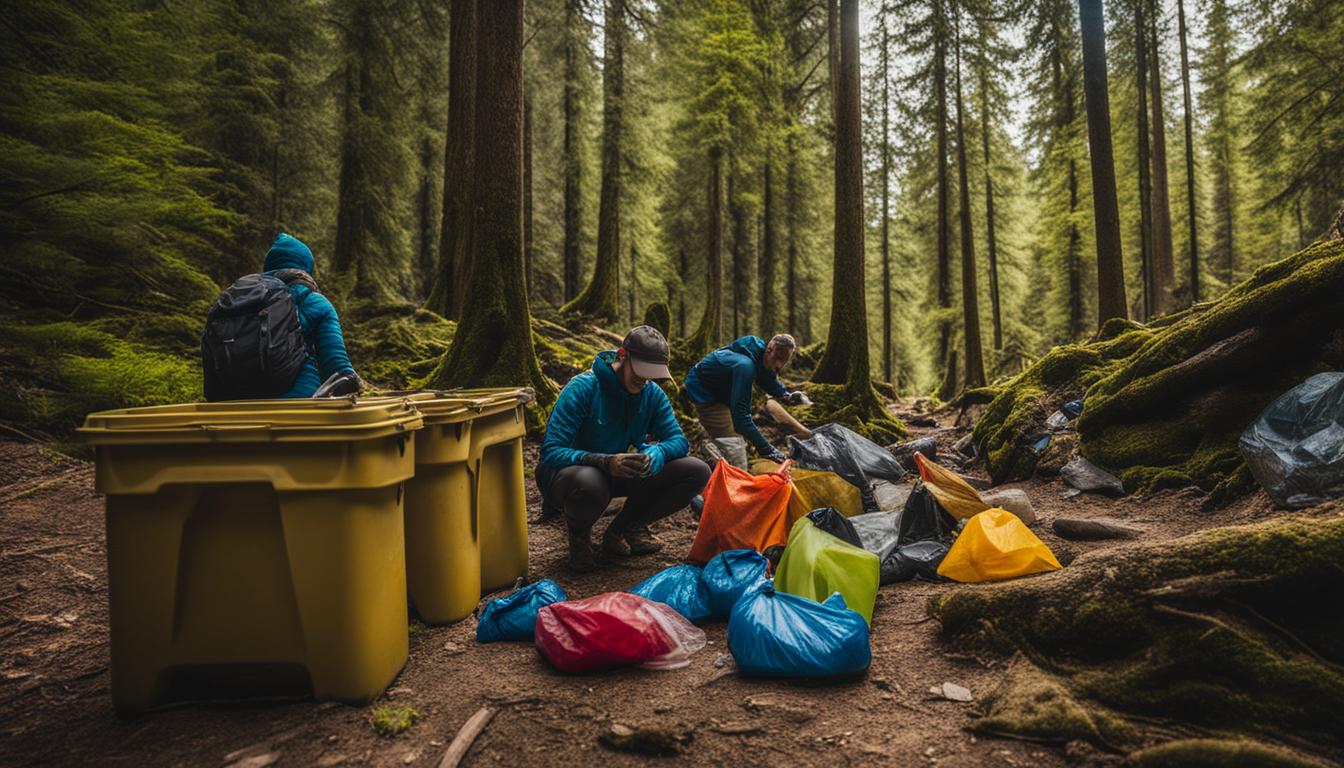When it comes to enjoying the great outdoors, it’s crucial to practice responsible outdoor practices and preserve nature’s beauty. That’s where the Leave No Trace Principles come in. These principles provide a framework of minimum impact practices that can be applied in any outdoor setting, from remote wilderness areas to local parks. By understanding and applying these principles, we can all do our part to minimize our impact on the environment.
Key Takeaways:
- Leave No Trace Principles are essential for responsible outdoor practices.
- By following these principles, we can minimize our impact on the environment.
- Leave No Trace Principles apply to various outdoor settings, from wilderness areas to local parks.
- Understanding and applying these principles helps preserve nature’s beauty for future generations.
- Practicing Leave No Trace is a way to become an environmental steward and contribute to conservation efforts.
The Seven Principles of Leave No Trace for Backpackers
As a backpacker, it is crucial to embrace responsible outdoor practices and minimize our impact on the wilderness. This can be achieved by following the seven principles of Leave No Trace. These principles serve as a guide to ensure that we tread lightly and preserve the beauty of nature for future generations.
1. Plan Ahead and Prepare
Before embarking on a backpacking trip, it is essential to plan ahead and be well-prepared. This includes researching the area, understanding the regulations and concerns, and acquiring the necessary permits. By being prepared, we can make informed decisions and minimize our impact on the environment.
2. Travel and Camp on Durable Surfaces
When backpacking, it is important to stick to established trails and camp on durable surfaces. This prevents unnecessary damage to fragile ecosystems and helps preserve the natural habitats of plants and wildlife. By minimizing our footprint, we can ensure that future backpackers can enjoy the wilderness in its pristine state.
3. Dispose of Waste Properly
Proper waste disposal is a vital aspect of Leave No Trace. Backpackers should carry out all trash and dispose of it in designated receptacles. When it comes to human waste, using catholes at least 200 feet away from water sources and campsites is essential. By leaving no trace of our waste, we protect water quality and prevent the spread of disease.
4. Leave What You Find
One of the fundamental principles of Leave No Trace is to leave natural objects untouched. This includes rocks, plants, and other natural features. By leaving them as we found them, we contribute to the preservation of biodiversity and help maintain the integrity of the ecosystem.
5. Minimize Campfire Impacts
Campfires can leave lasting impacts on the environment, so it’s important to minimize their impact. When feasible, it’s best to use a lightweight camping stove instead. If building a campfire is necessary, use established fire rings and follow local regulations. After use, make sure the fire is completely extinguished and the site is restored to its natural state.
6. Respect Wildlife
When encountering wildlife during a backpacking trip, it is crucial to observe from a safe distance and avoid disturbing their natural behaviors. Feeding or approaching wildlife can have detrimental effects on their health and disrupt the delicate balance of ecosystems. By respecting wildlife, we contribute to their wellbeing and the overall health of the wilderness.
7. Be Considerate of Other Visitors
Sharing the wilderness with other backpackers and outdoor enthusiasts requires consideration and respect. Being mindful of noise levels, yielding the right of way on trails, and maintaining a positive attitude towards fellow adventurers all contribute to a harmonious outdoor experience. By being considerate, we create a welcoming and enjoyable environment for everyone.
| Principle | Description |
|---|---|
| Plan Ahead and Prepare | Research the area, understand regulations, and be well-prepared. |
| Travel and Camp on Durable Surfaces | Stick to established trails and camp on durable surfaces. |
| Dispose of Waste Properly | Carry out all trash and use catholes for human waste. |
| Leave What You Find | Do not disturb natural objects or features. |
| Minimize Campfire Impacts | Use camping stoves when possible, and follow fire regulations. |
| Respect Wildlife | Observe wildlife from a safe distance and avoid disturbing them. |
| Be Considerate of Other Visitors | Show respect and consideration towards fellow outdoor enthusiasts. |
Incorporating these seven principles into our backpacking adventures ensures that we leave no trace and protect the wilderness we cherish. By practicing responsible outdoor practices, we can help preserve the natural beauty of our surroundings and contribute to the sustainability of our planet.
How to Practice Leave No Trace on Backpacking Trips

When embarking on a backpacking trip, it is crucial to practice the principles of Leave No Trace to ensure responsible outdoor practices and minimize our impact on the wilderness. By implementing these principles in a practical manner, we can preserve the beauty of our natural surroundings and contribute to the sustainability of our environment.
Planning and Preparation
The first step in practicing Leave No Trace on backpacking trips is to plan ahead and prepare for our adventure. This includes researching the regulations and concerns of the area we will be visiting and obtaining any necessary permits. By familiarizing ourselves with the local environment, we can make informed decisions on how to best protect it.
Additionally, packing essential gear such as a lightweight tent, camp stove, and appropriate clothing ensures that we are well-prepared for our trip. This not only minimizes waste but also allows us to leave unnecessary items behind, reducing our overall impact on the environment.
Campsite Selection and Waste Disposal
Choosing appropriate campsites and practicing proper waste disposal are essential in Leave No Trace backpacking. It is important to camp on durable surfaces such as established trails or designated campsites to prevent unnecessary damage to vegetation and soil. By avoiding fragile areas, we can minimize our impact on the ecosystem.
When it comes to waste disposal, carrying out all trash and packing out any litter helps to maintain the pristine condition of the wilderness. Additionally, using catholes for human waste and following proper hygiene practices ensures that we leave the environment in the same condition as we found it.
Respecting Wildlife and Fellow Visitors
Respecting wildlife and being considerate of other visitors are crucial aspects of Leave No Trace on backpacking trips. By observing wildlife from a distance and refraining from feeding or approaching them, we can preserve their natural behaviors and habitats. It is also important to minimize noise and avoid crowded areas, allowing other visitors to enjoy the tranquility of the wilderness.
Overall, practicing Leave No Trace on backpacking trips requires a mindful and responsible approach to outdoor adventures. By following these principles, we can ensure that the wilderness remains pristine for future generations to enjoy.
Teaching Leave No Trace Principles to Beginner Backpackers
As an experienced outdoor enthusiast, I understand the importance of responsible outdoor practices. That’s why I believe it is crucial to teach Leave No Trace principles to beginner backpackers. By providing them with the knowledge and tools to minimize their impact on the environment, we can create a generation of responsible outdoor enthusiasts who will help preserve the natural beauty we all love.
Outdoor education plays a vital role in teaching beginner backpackers about Leave No Trace principles. Through workshops, classes, and guided trips, we can introduce them to the seven principles and explain why they are essential. By breaking down each principle and providing practical examples, beginners can better understand how their actions can affect the environment and learn how to make the right choices in the wild.
The Benefits of Teaching Leave No Trace
Teaching beginner backpackers about Leave No Trace principles goes beyond just preserving nature’s beauty. It also fosters a sense of environmental stewardship and encourages a deeper connection with the natural world. When beginners understand the impact of their actions, they are more likely to appreciate and respect the wilderness. This newfound knowledge can lead to a lifelong commitment to responsible outdoor practices, ensuring the sustainability of our outdoor spaces for generations to come.
Furthermore, teaching Leave No Trace principles to beginner backpackers helps create a community of like-minded individuals who share a common goal of environmental conservation. By instilling these principles from the start, we can establish a culture of sustainability in outdoor recreation, where every individual understands their role in protecting and preserving our natural resources.
“Leave No Trace principles are not just rules to follow; they are a way of life in the outdoors. By teaching beginners about these principles, we are empowering them to make responsible choices and be guardians of our natural spaces.” – John Smith, Outdoor Educator
Conclusion
As outdoor enthusiasts, it is our responsibility to practice Leave No Trace and uphold responsible outdoor practices. By doing so, we can contribute to preserving the beauty of nature and ensuring its sustainability for future generations.
Leave No Trace Principles provide a framework for minimizing our impact on the environment. Whether we are backpacking in the wilderness or exploring local parks, adhering to these principles allows us to enjoy outdoor adventures while leaving nature undisturbed.
Preserving nature goes beyond personal enjoyment; it is an act of environmental stewardship. By understanding and applying Leave No Trace, we become guardians of the natural world, actively taking part in its conservation. Our actions today have a lasting impact on the ecosystems we adore.
Together, let’s embrace responsible outdoor practices and be mindful of the Leave No Trace Principles. Through our actions, we can make a difference and ensure that the breathtaking landscapes we love remain unspoiled for generations to come.
FAQ
What are the Leave No Trace Principles?
The Leave No Trace Principles provide a framework of minimum impact practices for anyone visiting the outdoors. They are continuously updated based on insights from biologists, land managers, and outdoor education experts.
Where can the Leave No Trace Principles be applied?
The Leave No Trace Principles can be applied in various settings, from remote wilderness areas to local parks.
How many Leave No Trace Principles are there?
There are seven Leave No Trace Principles for responsible outdoor practices.
What are the seven Leave No Trace Principles?
The seven Leave No Trace Principles include: Plan Ahead and Prepare, Travel and Camp on Durable Surfaces, Dispose of Waste Properly, Leave What You Find, Minimize Campfire Impacts, Respect Wildlife, and Be Considerate of Other Visitors.
How can I practice Leave No Trace on backpacking trips?
Practicing Leave No Trace on backpacking trips involves implementing the seven principles in a practical manner, such as planning ahead, camping on durable surfaces, disposing of waste properly, leaving natural objects untouched, minimizing campfire impacts, respecting wildlife, and being considerate of other visitors.
Why is it important to teach Leave No Trace Principles to beginner backpackers?
Teaching Leave No Trace Principles to beginner backpackers is essential to instill responsible outdoor practices from the start and create a culture of sustainability in outdoor recreation.
How can I contribute to the preservation of nature through Leave No Trace?
By understanding and applying the Leave No Trace Principles, individuals can make a significant impact in preserving the beauty of nature for future generations and become environmental stewards.

